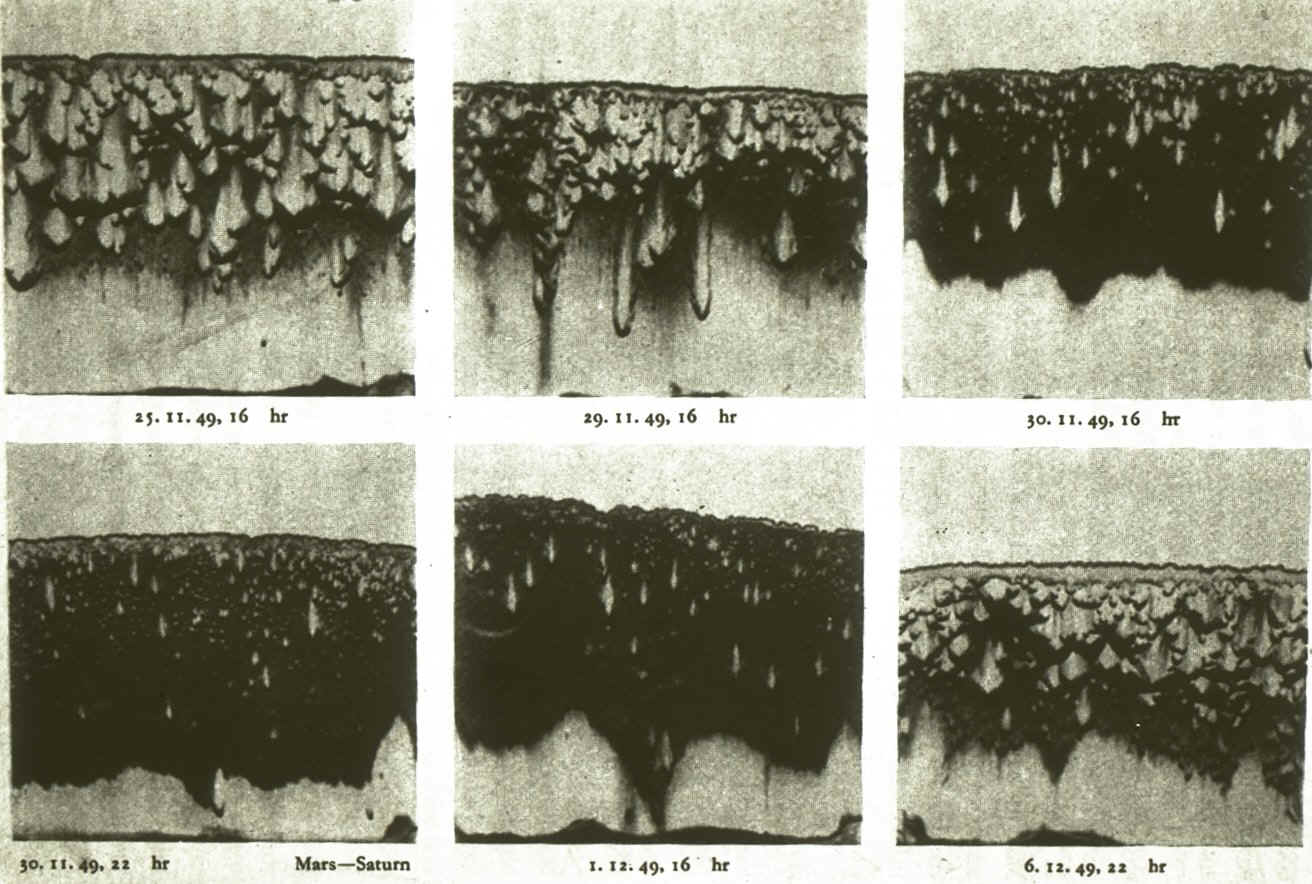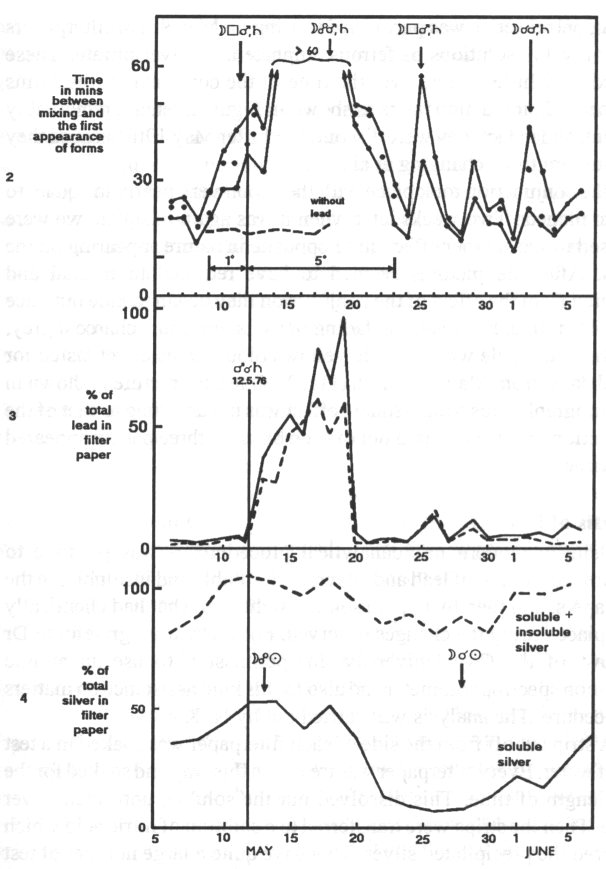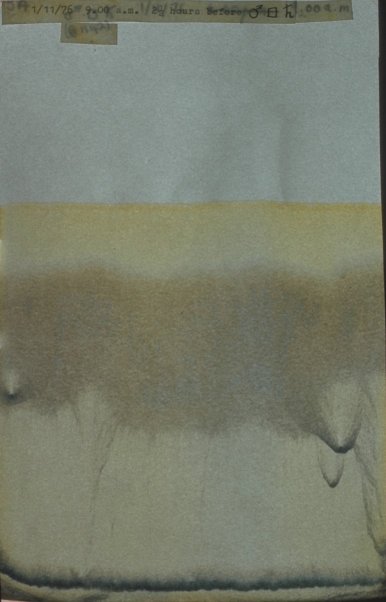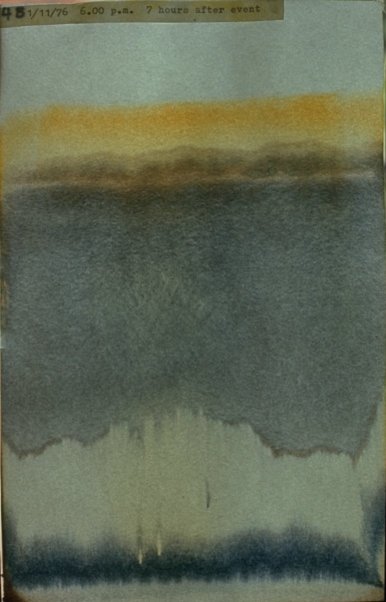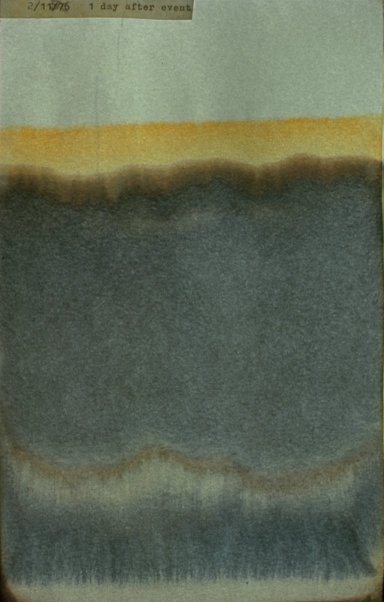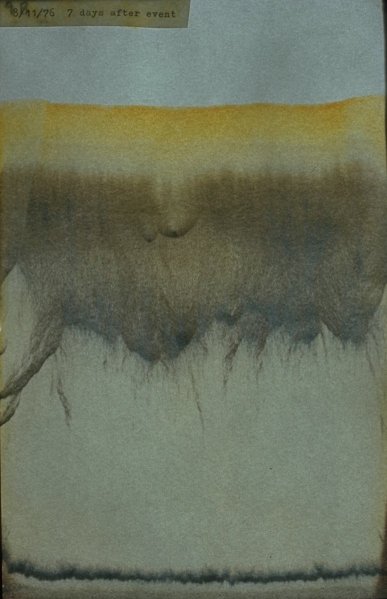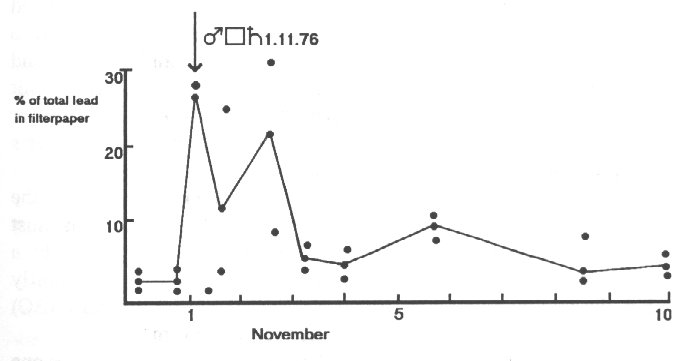- Metal-Planet Correspondences
- A Chemical Theatre
- Moon-Mars Experiments
- Mars-Saturn Experiments
- Moon-Saturn Experiments
- Gold and the Sun
- 2002 Experiments
- The Method
- The Astronomy
- Links
| Mars Saturn Experiments |
| 'Kolisko has shown us the way to a new chemistry, a chemistry full of life, because it is in reality the forces of life which reach right down into the mineral world, creating there a realm of inner music in tune with the harmony of the spheres above.' Michael Drummond (in Mercury Star journal, 1977)
|
|
| Experiments
using the three solutions, of iron, silver and lead. This type of metal-planet experiments has been done more frequently than others, because the metals corresponding to Mars and Saturn (iron and lead) work well in the filterpaper experiments which Kolisko devised. As well as her Saturn und Blei of 1952, experiments were also described by Dr Karl Voss in 1964, reported in the journal Neue Aspekte and by Rudolf Hauschka in 1973, in Pelikan's The Secrets of Metals. Michael Drummond's Mars-Saturn experiments, that I participated in, were described in 1977 in the UK's Astrological Journal, as Chemical Effects of a Mars-Saturn Conjunction. We used the method as modified by Agnes Fyfe, with the convenient small dishes made by the Lukas Klinik in Arlesheim, Basel, for the filterpapers.
30 November 1949 Here are some old photos of an experiment performed by Theodor Schwenk in the research laboratories of Weleda Company. He was using Kolisko's method to follow the Mars-Saturn conjunction of 30th November, 1949. The photos were reproduced in Wilhelm Pelikan's book, 'The Secrets of Metals'. Pelikan described the effect obtained by Schwenk during the conjunction as follows: 'The broad, heavy 'lead formations' become pointed and narrow and are reduced in number: a strong blackening of the background occurs.'
The first filterpaper was allowed to rise, with 1% solutions of lead nitrate, iron sulphate and silver nitrate, and this gives a normal-looking precipitate. These steigbilds were all done at the same time of day, 4 p.m. The next on the 29th, the day before the conjunction, shows a fading-away of forms, and instead a heavy darkness appears. Although it is just silver precipitating, the darkness looks as if lead-Saturn were doing it. On the 30th the day of the conjunction only small forms appear, swamped by the darkness, and likewise for the next day. Lastly on 6th of December a week later the forms have returned to normal.
15 March 1970 This was one of my first Mars-Saturn experiments and alas the photographs are very faded. They show the fading away of usual form during the conjunction and also some colour effects with reddish hues appearing at midnight.
12.50 and 13.38
Parallel experiments at 12.50, 13.38 and 18.30.
12th May 1976 Mars conjunct Saturn This was the classic series performed by chemist Michael Drummond, daily for one month. If anyone wants concrete, conclusive proof, here it is. Three sets were risen each day, and graphs were plotted of reaction time and degree of form. Later on I was able to perform a chemical analysis of the filterpapers and this showed a complete change in the lead rection over the event (see graphs below). During the conjunction and for days afterwards complete darkness-without-form appeared on the papers. The first two images show precipitation on days prior to the event. Then the conjunction happened at 3.46 p.m. on 12th May, when a swamping of forms is evident. The next three images show the gradual darkening up to May 19th i.e. over a 7-day period. Then suddenly on May 20th strong forms reappeared. One set of three filterpapers was risen each day at about 7 p.m.
These graphs show how each day from May 5th to June 5th reaction rate for silver precipitation and lead and silver present in the filterpaper varied. As can be seen from the first graph, there were three filterpapers set up per day. The first graph also indicates the concept of 'orb' for a conjunction, as extending one degree before the event and four or five degrees after. The first graph also shows a 'control' experiment as was performed with only silver and iron solution, as showed no change: it needed the lead to key into the Saturn-event. Normally, 99% or so of the lead will precipitate in the dish when the solutions are mixed, as insoluble lead sulphate. We had no suspicion that things were otherwise until well after Drummond had completed the experiment. I thn sliced off a small sliver from each paper and analysed it using an atomic absorbtion spectrophotometer. This measures element-composition quite quickly using light, in a flame. This became available because a chemist Dr Benbow of the City University had been asked by the BBC horizon team to checkup on this research-endeavour by the UK's Astrological Association, see previous section. He allowed me to do this in his 'combustion-research laboratory' as semed quite appropriate considering its martial context. For the record, I did the analysis during my Saturn-return at 29 years and with a Sun-Saturn conjunction in the sky. Huge amounts of excess lead were present in the conjunction-filterpapers. I had the test-tubes all randomised and R.M. then at the Government Chemist was helping me over the protocol. Summarising, I developed a threefold approach to monitoring the 'Kolisko effect' during this celestial event: recording reaction time, assesing the degree of form, and measuring the metal ions present in the filterpaper pictures after the event. This approach clearly demonstrated the working of specific metal-planet correspondences, both in picture-building and chemical reactions, over an orb of five of six degrees.
Dates of above pictures:
1st November 1976 Mars Square Saturn Drummond did three more of the Mars-Saturn aspects, viz. a square, trine and sextile. Lovely purplish hues appeared, and the darkness- without form did reappear but less and less heavily, his sextile-aspect experiment being quite a light affair. I provided him with the chemicals, and in particular with ampoules of ferrous sulphate as he kept frozen in his fridge, because it didn't keep (it becomes hydrated and soon goes off with a brown colour). The graph shows my measurement of the lead present in his filterpapers. This time there was a much smaller percentage of the lead as did not react (like it should have done) but climbed up into the filterpaper. As a square is a weaker event than a conjunction, this is what one would expect. The sequence of photographs does well delineate the progress of this celestial event, showing the marvellous purple hues as appeared during it. The purple and red hues were produced solely by the metallic silver. Such rather special effects during the event, are the reward which the operator receives for conducting the experiment.
1 November 1976 09.00 1 November 1976 18.00
2 November 1976 (one day after the event) 8 November 1976 (7 days after the event)
Graph from A Metal Planet Relationship -- A Study of Celestial Influence by Nick Kollerstrom, Borderland Sciences Research Foundation, 1973, Page 39.
4 May 2002 (Experiment by Guy Desbiolles)
Images and text by Nick Kollerstrom. nk@astro3.demon.co.uk |
|
